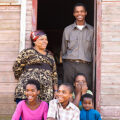minority news
BALTIMORE – A new survey released by the Annie E. Casey Foundation, a private charitable organization, says that child poverty in the United States increased in 38 states in the last decade.
The annual KIDS COUNT Data Book shows the official child poverty rate, which is a conservative measure of economic hardship, increased 18 percent between 2000 and 2009, essentially returning to the same level as the early 1990s.
This increase means that 2.4 million more children are living below the federal poverty line. Data also reveals the impact of the job and foreclosure crisis on children. In 2010, 11 percent of children had at least one unemployed parent and 4 percent have been affected by foreclosure since 2007.
The survey ranks states based on 10 key indicators, such as the number of infant mortalities, teen births, children in single-parent families and undernourished infants.
The charitable organization bases its report on data from many sources, including the U.S. Census Bureau, the National Delinquency Survey and the Mortgage Bankers’ Association.
“In 2009, 42 percent of our nation’s children, or 31 million, lived in families with incomes below twice the federal poverty line or $43,512/year for a family of four, a minimum needed for most families to make ends meet,” said Laura Speer, associate director for Policy Reform and Data at the Casey Foundation.
“The recent recession has wiped out many of the economic gains for children that occurred in the late 1990s. Nearly 8 million children lived with at least one parent who was actively seeking employment but was unemployed in 2010. This is double the number in 2007, just three years earlier. The news about the number of children who were affected by foreclosure in the United States is also very troubling because these economic challenges greatly hinder the well-being of families and the nation.”
Three areas have worsened: the percent of babies born low-birthweight, the child poverty rate, and the percent of children living in single-parent families.
New Hampshire, Minnesota, and Massachusetts rank highest, while Alabama, Louisiana, and Mississippi rank the lowest.
The eight states with the biggest improvements in their rankings between 2000 and the most recent years of data are New York, Maryland, Connecticut, Massachusetts, North Carolina, Oregon, Virginia and Wyoming.
The five states with the biggest drops in their rankings are South Dakota, Maine, West Virginia, Hawaii and Montana.
“The research and data tell us that children who grow up in low-income families are less likely to successfully navigate life’s challenges and achieve future success,” said Patrick T. McCarthy, president and CEO of the Casey Foundation. “To decrease the numbers of children who are at risk for bad outcomes as a consequence of economic hardship, we must invest in strategies that can help children reach their full potential. In the wake of the recession, the Casey Foundation urges policymakers to focus on ensuring the next generation of children is healthy, educated, and prepared to compete in a global economy.”
The 2011 Data Book message, “America’s Children, America’s Challenge: Promoting Opportunity for the Next Generation,” examines how children and families are faring in the wake of the recession and ties together research findings on family economic success and the critical role of investing in early childhood programs that can allow the next generation to succeed. At the core of the message is the Casey Foundation’s belief that providing the opportunity for all children to succeed requires two-generation strategies that simultaneously help parents put their families on a path to economic success and enhance children’s social, emotional, cognitive, and physical development from birth.
“There is a great deal of knowledge about how to help struggling families get back on track and increase their children’s chances for success while building a vibrant economy,” concluded McCarthy. “In the years following World War II, we made great progress in child well-being and reduced many of the disparities associated with the differences in income and wealth, and race and ethnicity. Our challenge now is to find the will to make sound investments that can improve the economic prospects for families today while preparing our children for the future. “
















Leave a Comment